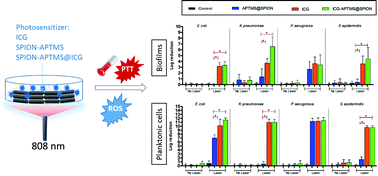Broad spectrum antibacterial photodynamic and photothermal therapy achieved with indocyanine green loaded SPIONs under near infrared irradiation†
Abstract
Antimicrobial photodynamic therapy (aPDT) and antimicrobial photothermal therapy (aPTT) are promising local and effective alternative therapies for antibiotic resistant bacterial infections and biofilms. A combination of nanoparticles and organic photosensitizers offers a great opportunity to combine PDT and PTT for effective eradication of both planktonic bacteria and their biofilms. In this work, photo-induced antibacterial activity of indocyanine green (ICG), 3-aminopropylsilane coated superparamagnetic iron oxide nanoparticles (APTMS@SPIONs) and ICG loaded APTMS@SPIONs was evaluated on planktonic cells and biofilms of Gram-negative (E. coli, K. pneumoniae, P. aeruginosa) and Gram-positive (S. epidermis) bacteria. A relatively low dose of ICG (25 μg mL−1) and SPIONs (0.425 μg mL−1 nanoparticle) in combination with single, short (10 min) laser irradiation at 808 nm with a power of 1150 mW was used in this study. No dark toxicity of the agents or antibacterial effect of the laser irradiation was observed. The charge of the particles did not provide a significant difference in their penetration to Gram-negative versus Gram-positive bacterial strains or their biofilms. APTMS@SPION/laser treatment completely eliminated P. aeruginosa and provided 7-log reduction in the colony forming unit (CFU) of E. Coli, but was not effective on the other two bacteria. This is the first example for antibacterial phototoxicity of this nanoparticle. ICG/laser and ICG-APTMS@SPION/laser treatments provided complete killing of all planktonic cells. Successful eradication of all biofilms was achieved with ICG/laser (3.2–3.7 log reduction in CFUs) or ICG-APTMS@SPION/laser treatment (3.3–4.4 log reduction in CFUs). However, an exceptionally high, 6.5-log reduction as well as a dramatic difference between ICG versus ICG/APTMS@SPION treatment was observed in K. pneumoniae biofilms with ICG-APTMS@SPION/laser treatment. Investigation of the ROS production and increase in the local temperature of the biofilms that were subjected to phototherapy suggested a combination of aPTT and aPDT mechanisms for phototoxicity, exhibiting a synergistic effect when ICG-APTMS@SPION/laser was used. This approach opens an exciting and novel avenue in the fight against drug resistant infections by successfully utilizing the antimicrobial and antibiofilm activity of low dose FDA approved optically traceable ICG and relatively low cost clinically acceptable iron oxide nanoparticles to enable effective aPDT/aPTT combination, induced via short-duration laser irradiation at a near-infrared wavelength.

- This article is part of the themed collection: Biomaterials Science 10th Anniversary: Top papers from Europe


 Please wait while we load your content...
Please wait while we load your content...